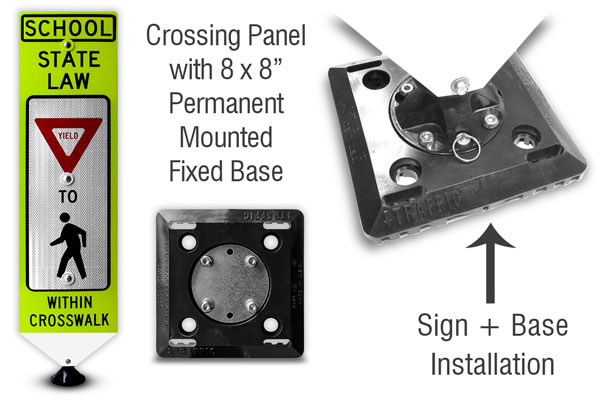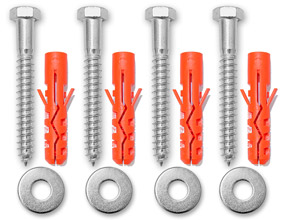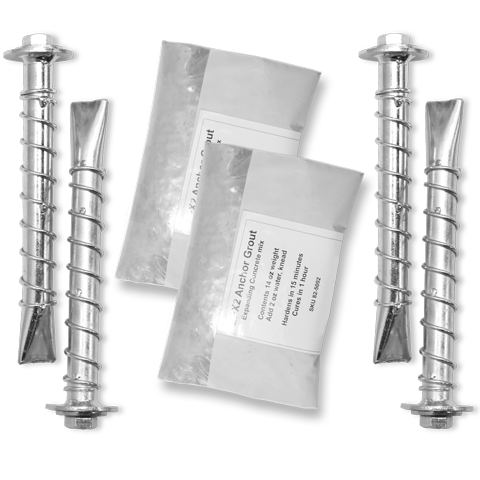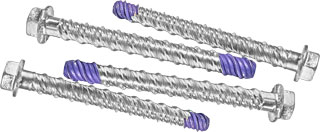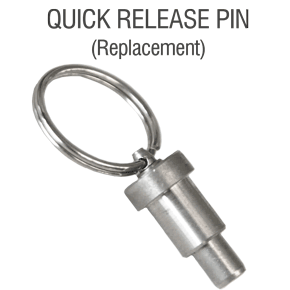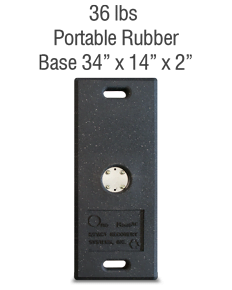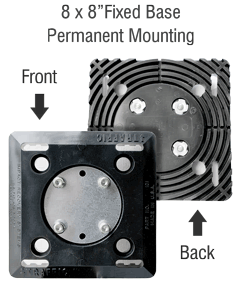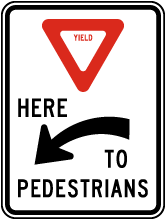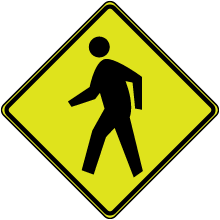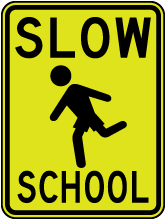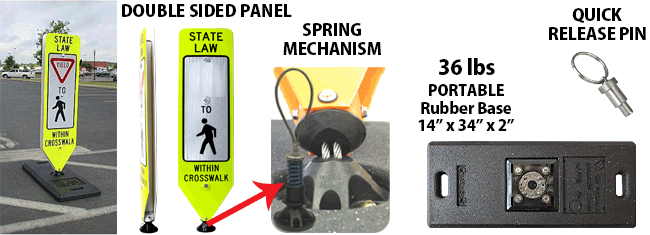- Item #
- Y4941
- Compliance
-
- MUTCD R1-6
- NCHRP 350 Approved
Note:
Recommended Accessories
Product Information
Details
A School Yield To Pedestrians In-Street Sign with Fixed Base is MUTCD compliant for traffic and pedestrian safety compliance. A School Yield To Pedestrians In-Street Sign with Fixed Base is a helpful resource to help protect the drivers and pedestrians on public roadways, private drives, and parking lots.
Sign and Base options:
Compliance
Pedestrian Crossing Panel Specifications
Size: 12" x 47" Fluorescent Yellow-Green Diamond Grade Reflective Sheeting.
With 10 x 24" White High Intensity Reflective Sheeting Insert (white area where image and content is specified)
This Panel is Double Sided (2 signs, one on each side containing the same information and supported with a high impact plastic post).
State Law Yield/Stop for Pedestrians Within Crosswalk Panels meet MUTCD Section 2B.12 In-Street Pedestrian Crossing Signs (R1-6, R1-6a)
- Durable molded polyethylene panels and recycled rubber bases.
- For transportation and storage, both the panels and base can be easily separated and stacked.
- When impacted by a vehicle each panel reactive spring gives upon impact and is designed to consistently return the post or panel to its original position.
- The panel face is recessed to minimize abrasions and scratches to the expensive reflective sheeting.
- Panel Dimensions: 12" wide x 47" high (Double Sided)
- Double Paneled Unit has a reactive spring assembly tested at 200 lb tension with stainless steel cable.
Base Specifications
- Bases are made from 100% recycled rubber
- Weight: 36 lbs.
- Dimensions: 34" x 14" x 2"
Base comes standard with quick release feature that allows upright installation and removal in less than 5 seconds. Installation: each portable base is supplied with 4 bolts to secure each panel in place, place panel on top of the base (screws will be positioned inside the bigger holes), rotate panel about 15° and snap into place (screws will lock into place inside the smaller holes). No extra accessories or tools are required for this assembly.
Pedestrian Crossing Panel Assembly
State Specific
SafetySign.com Disclaimer: As of January, 2016 the information below represents the most recent information readily available online related to "State Law Yield-Stop to Pedestrians at Crosswalks by State". Each State may have additional and/or more accurate information available to its residents through state government offices and websites. SafetySign.com makes no warranties or guarantees as to the accuracy and/or any updates related to changes in specific state regulations contained on this site. Please check official sources such as city halls, police stations, local and state websites, etc; prior to purchasing the sign above.
New Jersey: MOTORISTS in New Jersey MUST stop for pedestrians in a marked crosswalk. Read more about it here →
Arizona: 28-792. Right-of-way at crosswalk
- Except as provided in section 28-793, subsection B, if traffic control signals are not in place or are not in operation, the driver of a vehicle shall yield the right-of-way, slowing down or stopping if need be in order to yield, to a pedestrian crossing the roadway within a crosswalk when the pedestrian is on the half of the roadway on which the vehicle is traveling or when the pedestrian is approaching so closely from the opposite half of the roadway as to be in danger. Read more about it here →
California: V C Section 21950 Right of Way at Crosswalks.
21950. (a) The driver of a vehicle shall yield the right-of-way to a pedestrian crossing the roadway within any marked crosswalk or within any unmarked crosswalk at an intersection, except as otherwise provided in this chapter.Read more about it here →
Connecticut: Sec. 14-300. Crosswalks. Pedestrian-control signals. Regulation of pedestrians and motor vehicles at crosswalks. Pedestrians who are blind or have guide dogs.
Except as provided in subsection (c) of section 14-300c, at any crosswalk marked as provided in subsection (a) of this section or any unmarked crosswalk, provided such crosswalks are not controlled by police officers or traffic control signals, each operator of a vehicle shall grant the right-of-way, and slow or stop such vehicle if necessary to so grant the right-of-way, to any pedestrian crossing the roadway within such crosswalk, provided such pedestrian steps off the curb or into the crosswalk at the entrance to a crosswalk or is within that half of the roadway upon which such operator of a vehicle is traveling, or such pedestrian steps off the curb or into the crosswalk at the entrance to a crosswalk or is crossing the roadway within such crosswalk from that half of the roadway upon which such operator is not traveling... Read more about it here →
Colorado: What rules are important for pedestrians and drivers to know about crossing in a crosswalk?
State law requires that pedestrians give vehicles the opportunity to stop before entering a crosswalk. Drivers shall yield the right of way to pedestrians on a sidewalk or approaching or within a crosswalk. Read more about it here →
DC: 2208 Right-of-way: Intersections
When official traffic-control signals are not in place or not in operation, the driver of a vehicle shall stop and give the right-of-way to a pedestrian crossing the roadway within any marked crosswalk or unmarked crosswalk at an intersection. (DC requires the sign to read DC LAW) Read more about it here →
Florida: When an In-Street Pedestrian Crossing sign is used, it needs to have the legend STOP FOR [PEDESTRIAN symbol)] WITHIN CROSSWALK. Read more about it here →
Georgia: Georgia Pedestrian Traffic Laws /O.C.G.A. §40-6-91. Right of way in crosswalks.
The driver of a vehicle shall stop and remain stopped to allow a pedestrian to cross the roadway within a crosswalk when the pedestrian is upon the half of the roadway upon which the vehicle is traveling, or when the pedestrian is approaching and is within one lane of the half of the roadway on which the vehicle is traveling or onto which it is turning. For the purposes of this subsection, "half of the roadway" means all traffic lanes carrying traffic in one direction of travel. Read more about it here →
Hawaii: New Pedestrian Law
The Driver of a vehicle shall STOP and yield the right of way, to a pedestrian crossing the roadway within a crosswalk when the pedestrian is upon the half of the roadway upon which the vehicle is traveling, or when the pedestrian is approaching so closely from the opposite half of the roadway as to be in danger. Read more about it here →
Illinois: The right of way at crosswalks, extracted from the Illinois Vehicle Code, Rules of the Road, 625 ILCS 5/11-1002 Sec. 11-1002. Pedestrians' right-of-way at crosswalks.
- When traffic control signals are not in place or not in operation the driver of a vehicle shall stop and yield the right-of-way to a pedestrian crossing the roadway within a crosswalk when the pedestrian is upon the half of the roadway upon which the vehicle is traveling, or when the pedestrian is approaching so closely from the opposite half of the roadway as to be in danger.
- No pedestrian shall suddenly leave a curb or other place of safety and walk or run into the path of a moving vehicle which is so close as to constitute an immediate hazard. Read more about it here →
Iowa: Under Iowa law, pedestrians have the right of way in marked crosswalks, and motorists should yield to the pedestrian when they are in those crosswalks. Read more about it here →
Kansas: 8-1533. Same; right-of-way at crosswalks; interference with vehicular traffic; duties of drivers. (Crosswalk responsibilities defined).
- (a) When traffic-control signals are not in place or not in operation the driver of a vehicle shall yield the right-of-way, slowing down or stopping if need be to so yield, to a pedestrian crossing the roadway within a crosswalk when the pedestrian is upon the half of the roadway upon which the vehicle is traveling, or when the pedestrian is approaching so closely from the opposite half of the roadway as to be in danger. Read more about it here →
Kentucky: 189.570 Pedestrians.
- When traffic control signals are not in place or in operation the operator of a vehicle shall yield the right-of-way, slowing down or stopping if need be to so yield, to a pedestrian crossing the roadway upon which the vehicle is traveling, or when the pedestrian is approaching so closely from the opposite half of the roadway as to be in danger. Read more about it here →
Louisiana: §212. Pedestrians right-of-way in crosswalks
- When traffic-control signals are not in place or not in operation, the driver of a vehicle shall stop and yield the right-of-way, to a pedestrian crossing the roadway within a crosswalk when the pedestrian is upon the roadway upon which the vehicle is traveling or the roadway onto which the vehicle is turning. B. No pedestrian shall suddenly leave a curb or other place of safety and walk or run into the path of a vehicle which is so close that it is impossible for the driver to yield. Read more about it here →
Maine: Maine Pedestrian Laws
- Pedestrian traffic. When use of a sidewalk next to a public way is practicable, a pedestrian may not walk on that public way.
Pedestrian on way. Where sidewalks are not provided, a pedestrian shall walk facing approaching traffic on the left side of the public way or the way's shoulder when practicable.
Pedestrians on sidewalks. An operator shall yield the right-of-way to a pedestrian on a sidewalk. Pedestrians in marked crosswalks. When traffic-control devices are not in operation, an operator must yield the right-of-way to a pedestrian crossing within a marked crosswalk. Pedestrian crossing. A pedestrian must yield the right-of-way to a vehicle when crossing a way:- Other than within a marked crosswalk; or
- With an available pedestrian tunnel or overhead pedestrian crossing.
Maryland: In-street pedestrian crossing signs are used at uncontrolled crossing locations to remind motorists that state law requires them to STOP for pedestrians within a crosswalk. Read more about it here →
Massachusetts: Section 11. When traffic control signals are not in place or not in operation the driver of a vehicle shall yield the right of way, slowing down or stopping if need be so to yield, to a pedestrian crossing the roadway within a crosswalk marked in accordance with standards established by the department of highways if the pedestrian is on that half of the traveled part of the way on which the vehicle is traveling or if the pedestrian approaches from the opposite half of the traveled part of the way to within 10 feet of that half of the traveled part of the way on which said vehicle is traveling. Read more about it here →
Michigan: Pedestrian and Bicycle Safety Tips.
Drivers should:
- Look out for and always yield the right-of-way to people walking, jogging, biking, etc; Pull out slowly from driveways and parking areas while watching for vulnerable road users, including children and others on the sidewalk or nearby pathways;
- Stop fully before turning at driveways and intersections to make sure you do not cut off pedestrians or approaching bicyclists with right of way; Never turn right immediately after passing a cyclist - wait until the cyclist has completed the trip through the intersection; Do not pass vehicles stopped at crosswalks, as they may be allowing a pedestrian to cross the street; Yield to anyone crossing the street when turning left on a green light.
Read more about it here →
Minnesota: You can use the "STATE LAW STOP FOR PED (with 2 symbols) or you can use their unique design, which is "STATE LAW STOP FOR PED (Mostly text, which we DO NOT carry at the moment). View MN MUTCD Version. Subd. 2.Rights in absence of signal. (a) Where traffic-control signals are not in place or in operation, the driver of a vehicle shall stop to yield the right-of-way to a pedestrian crossing the roadway within a marked crosswalk or at an intersection with no marked crosswalk. Read more about it here →
Missouri: Chapter 300 Model Traffic Ordinance Section 300.375 / Pedestrians' right-of-way in crosswalks.
- 300.375. 1. When traffic control signals are not in place or not in operation the driver of a vehicle shall yield the right-of-way, slowing down or stopping if need be to so yield, to a pedestrian crossing the roadway within a crosswalk when the pedestrian is upon the half of the roadway upon which the vehicle is traveling, or when the pedestrian is approaching so closely from the opposite half of the roadway as to be in danger. Read more about it here →
Nevada: Drivers must:
- Must exercise due care to avoid a collision with a pedestrian at all times. (NRS 484B.280)
- Must yield to pedestrians in crosswalks. (NRS 484B.283)
- Must yield at all times to a blind person using a white cane or service animal. (NRS 484B.290)
- Must stop or slow down before passing another vehicle stopped in a travel lane until the driver has determined whether that vehicle has stopped for a pedestrian. (NRS 484B.283)
- Must, in the presence of a school crossing guard, wait for all persons including the guard to completely clear the road before proceeding. (NRS 484B.350)
Read more about it here →
New Hampshire: 265:35 Pedestrian’s Right Of Way In Crosswalks
- When traffic control signals are not in place or not in operation the driver of a vehicle shall yield the right of way, slowing down or stopping if need be to so yield, to a pedestrian crossing the roadway within a crosswalk when the pedestrian is upon the half of the roadway upon which the vehicle is traveling, or when the pedestrian is approaching so closely from the opposite half of the roadway as to be in danger.
Read more about it here →
New Mexico: 66-7-334. Pedestrians' right of way in crosswalks.
- When traffic-control signals are not in place or not in operation, the driver of a vehicle shall yield the right of way, slowing down or stopping if need be to so yield, to a pedestrian crossing the roadway within a crosswalk when the pedestrian is in the crosswalk.
New York: §1151. Pedestrians' right of way in crosswalks.
- When traffic-control signals are not in place or not in operation the driver of a vehicle shall yield the right of way, slowing down or stopping if need be to so yield, to a pedestrian crossing the roadway within a crosswalk on the roadway upon which the vehicle is traveling, except that any pedestrian crossing a roadway at a point where a pedestrian tunnel or overpass has been provided shall yield the right of way to all vehicles. Read more about it here →
North Carolina: Section 20-173. Pedestrians' right-of-way at crosswalks.
- Where traffic-control signals are not in place or in operation the driver of a vehicle shall yield the right-of-way, slowing down or stopping if need be to so yield, to a pedestrian crossing the roadway within any unmarked crosswalk at or near an intersection, except as otherwise provided in part 11 of this Article. Read more about it here →
South Carolina: Sharing the Road with Pedestrians
At the crosswalk you should yield by slowing or stopping for a pedestrian who is on your side of the roadway, or who is close enough to your side to be in danger. Unless they are at an intersection or within a marked crosswalk, pedestrians must yield to vehicles. Pedestrians must walk facing traffic. In entering an intersection on a green signal, a driver making a right or left turn is required by law to yield to pedestrians on the cross street lawfully within the intersection. Do not stop in a crosswalk.
Ohio: 4511.46 Right-of-way of pedestrian within crosswalk.
- 4511.46 Pedestrian on Crosswalk has Right of Way When traffic controls are not in place or not in operation, a driver shall yield the right of way to a pedestrian crossing the roadway in a crosswalk when the pedestrian is upon the same half of the roadway as the driver, or so close as to be in danger. No pedestrian shall step off the curb and walk or run into the path of vehicles so close as to be an immediate hazard.
Read more about it here →
Oklahoma: Pedestrians Right of Way in Crosswalks.
- 47 O.S. 11-502 a.When traffic control signals are not in place, or not in operation, the driver of a vehicle must yield the right of way, either by slowing down or stopping, if need be to do so yield, to a pedestrian crossing the roadway within a crosswalk when the pedestrian is upon the half of the roadway upon which the vehicle is traveling, or when the pedestrian is approaching so closely from the opposite half of the roadway as to be in danger. Read more about it here →
Oregon: At any other crosswalks - whether marked with paint or unmarked - drivers must: Stop and remain stopped for pedestrians until they have cleared the lane in which you are traveling (or into which you are turning) and the next lane. Read more about it here →
Pennsylvania: Section 3542. Right-of-way of pedestrians in crosswalks.
- General rule.—When traffic-control signals are not in place or not in operation, the driver of a vehicle shall yield the right-of-way to a pedestrian crossing the roadway within any marked crosswalk or within any unmarked crosswalk at an intersection. Read more about it here →
Tennessee: TCA 55-8-134 - Pedestrian's Right-of-Way in Crosswalks
- Unless in a marked school zone when a warning flasher or flashers are in operation, when traffic-control signals are not in place or not in operation, the driver of a vehicle shall yield the right-of-way, slowing down or stopping if need be to so yield, to a pedestrian crossing the roadway within a crosswalk when the pedestrian is upon the half of the roadway upon which the vehicle is traveling, or when the pedestrian is approaching so closely from the opposite half of the roadway as to be in danger.
- When in a marked school zone when a warning flasher or flashers are in operation, the driver of a vehicle shall stop to yield the right-of-way to a pedestrian crossing the roadway within a marked crosswalk or at an intersection with no marked crosswalk. The driver shall remain stopped until the pedestrian has crossed the roadway on which the vehicle is stopped.
Read more about it here →
Texas: Safety Tips – Pedestrians and School Buses
- Pedestrians Yield to vehicles on the roadway if you cross the street at a place other than a marked crosswalk or pedestrian tunnel or crossing.
- If you’re hit while jaywalking, the driver may not be liable, and his or her auto insurance may not cover your injuries.
- Stay on sidewalks and the right-hand side of crosswalks. Drivers are supposed to yield the right of way to pedestrians in crosswalks.
- If the road has no sidewalk, walk on the left side of the road facing traffic.
Read more about it here →
Washigton State: RCW 46.61.235 Crosswalks.
- The operator of an approaching vehicle shall stop and remain stopped to allow a pedestrian or bicycle to cross the roadway within an unmarked or marked crosswalk when the pedestrian or bicycle is upon or within one lane of the half of the roadway upon which the vehicle is traveling or onto which it is turning. For purposes of this section "half of the roadway" means all traffic lanes carrying traffic in one direction of travel, and includes the entire width of a one-way roadway.
Read more about it here →
West Virginia: Chapter 17c. Traffic Regulations And Laws Of The Road. §17C-10-2. Pedestrians' right-of-way in crosswalks.
- When traffic-control signals are not in place or not in operation the driver of a vehicle shall yield the right-of-way, slowing down or stopping if need be to so yield, to a pedestrian crossing the roadway within a crosswalk when the pedestrian is upon the half of the roadway upon which the vehicle is traveling, or when the pedestrian is approaching so closely from the opposite half of the roadway as to be in danger, but no pedestrian shall suddenly leave a curb or other place of safety and walk or run into the path of a vehicle which is so close that it is impossible for the driver to yield. This provision shall not apply under the conditions stated in section three paragraph (b) of this article.
Read more about it here →
Wisconsin Rules and pointers for pedestrians and drivers.
- Rules and pointers for pedestrians and drivers.
- Yield to pedestrians when crossing a sidewalk or entering an alley or driveway
- Yield to pedestrians who have started crossing at an intersection or crosswalk on a "walk" signal or a green light, if there is no walk signal
- Yield to pedestrians who are crossing the highway within a marked or unmarked crosswalk at an intersection where there are no traffic lights or control signals
- Not overtake and pass any vehicle that stops at an intersection or crosswalk to permit a pedestrian or bicyclist to cross the roadway safely.
Drivers Must:
Read more about it here →
